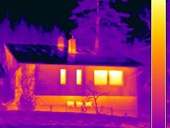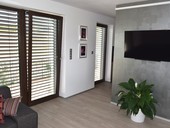In the first half of this year new came in force new standards that define new requirements for the design of thermo insulation systems in buildings. They are ČSN 73 0810 - Fire safety of buildings - Common provisions (April 2009) and ČSN 73 0802 - Fire safety of buildings- Non industrial buildings. The changes in these standards bring a number of major innovations. Let's have a look with them with the aid of images.From the result it is evident that the implementation of external thermal insulation systems for buildings with final approval before 200, and new buildings must follow the additional requirements listed in the articles of the standards ČSN 73 0810 and ČSN 73 0802, particularly in relation to the classification of types of components on the DP1, DP2, DP3. The implementation of additional insulation requires good design, preferably done by a specialist, the application of comprehensive quality and the choice of contractors with certifiable good references.
Archiv článků od 1.6.2009 do 9.11.2009
The interpretation of the concept of sustainability in the construction industry has developed these twenty years. In the first phase the problem of limited resources, especially energy had to be addressed as well as minimising the environmental impact of buildings and constructions processes. The next phase focused on the technical design of structures, particularly the choice of materials, building components, construction technologies and building design in order to increase their energy efficiency. Currently, the "soft" aspects of sustainability are gaining importance. They are generally regarded as crucial for a sustainable development in construction. The study results show that the traditional evaluation of projects can not dequately and comprehensively reflect effects of the environment and therefore, does not meet the principles of sustainable development. The work was created as part of the research project "Management of sustainable development, life cycle of buildings, construction firms and territories" (MSM 6840770006) funded by the Ministry of Education, Youth and Sports at the Czech Technical University in Prague, Faculty of Civil Engineering, and offers not only evaluation but also new options and Trends.
The new decree, no. 268/2009 Coll., of the Ministry of Regional Development on the technical requirements for construction will go into effect on August this year. We asked for a comment on this to the Engineer Jitka Vichova, a member of the Czech Society for Construction Law and the Authority Board of the Czech Chamber of Architects and examining commission ČKAIT for authorisation tests according to Law No. 360/1992 Coll.
The application potential for solar energy use in buildings lies in supply of thermal and electric energy and natural daylighting. To use incident solar energy from building envelope effectively, multi-functional construction elements combining several purposes should be introduced as a standard part of building construction. Examples of such concepts are presented: hybrid air/liquid collectors for heating and ventilation purposes, hybrid photovoltaic-thermal (PV/T) collectors for combined thermal and electric energy supply (glazed, unglazed, air/water cooled), linear Fresnell lenses collectors for removal of heat load from direct component of solar irradiation to thermal storage and allowing the natural diffuse daylighting.
The article reacts on changes that were made in program "Zelená úsporám" in recent days. Previous article described how to reach required standards for successful subsidy application in two ways. Following text focuses on changes in this approach both from subsidy amount and possibility of subsidy itself viewpoints. In general, portfolio of potential subsidy applicants has been extended, but necessary quality of subsidized measures has been kept.
The examination method Blower-Door test (fan pressurisation method) is used for measurements of air permeability of buildings and is also used for leakage detection. The result of the measurement is air leakage rate at the pressure differential across the building envelope of 50 Pa. The article points out leaky details which often appear at constructions. The article shows the possibility of using infrared camera and anemometer for leakage detection.
New Czech technical standard ČSN 73 0810 Fire protection of buildings - General requirements was issued in April 2009. This standard replaced the standard of the same title issued in June 2005. New standard has expanded or changed some of the paragraphs. Important changes are defined in the article.
Growing interest insulation very often results in choosing companies with low price for materials and installation, without considering whether technological standards are observed. The analysis of defects occurring in contact insulation systems should warn investors on how to proceed when choosing a supplier, so as to avoid claims for the resulting defects, or in a extreme case, so the insulation will not have to be replaced. It also wants to draw the attention of suppliers and designers towards those major faults when installing the contact insulation, and bring awareness to the general public about deficiencies that could arise, in particular with the implementation of contracts with no technical supervision.
Thermographic measurements and their subsequent diagnosis are a relatively quick method of non contact evaluation of buildings related to heating technology. Thermal images show complex temperature fields with optional colour scales and are thus very easy to understand even for a layman. The assessment and analysis of the temperature distribution allow the identification of places with elevated heat flow.
The article deals with the influence of the floor area of house energy supplied to the hot water. Mutually compare three methods of calculation and one of them use in the calculation of delivered energy for hot water system, through which energy class is designed for local consumption - the warm water.
Newly established program “Green Savings” based on income from CO2-emissions trade (Green Investment Scheme) brings several variants how to apply for subsidy for energy efficient building/renovation. Following text describes possible approaches to renovation with use of both thermal insulation of exterior constructions and change of windows/doors. Two examples of typical family houses are being described, each house in two variants of insulation (based on subsidy program criterion).
Important result is that almost all family houses that can be insulated with use of “partial insulation” subsidy, could gain higher subsidy with use of “complex insulation” criterion as well. Previous practice shows that majority of family houses can reach the higher subsidy (“complex insulation”).
Different prediction methods for the Sound Reduction Index of single building structures in laboratory conditions and for the Apparent Sound Reduction Index in buildings are presented in following paper. A short discussion of methods is done regarding to input data, assumptions of calculations etc. The main part of this paper is focused on a comparison between predicted and measured results, which leads to evaluation of methods´ accuracy. This paper is based on author´s PhD thesis.
zpět na aktuální články

